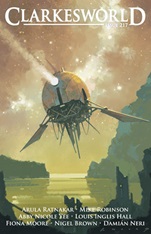 Clarkesworld #217, October 2024
Clarkesworld #217, October 2024
“A Space O/pera” by Abby Nicole Yee
“The Children of Flame” by Fiona Moore
“Fishing the Intergalactic Stream” by Louis Inglis Hall
“The Face of God: A Documentary” by Damián Neri
“The Buried People” by Nigel Brown
“Fractal Karma” by Arula Ratnakar
“Midnight Patron” by Mike Robinson
Reviewed by Victoria Silverwolf
Half a dozen short stories and a single novella appear in this issue.
In “A Space O/pera” by Abby Nicole Yee, the first Filipino satellite is launched into space with an elderly dog inside. When communication with the satellite is lost, the woman who owns the dog sneaks aboard another spacecraft to rescue it and makes an unexpected discovery.
The premise strains credibility and the plot makes the work seem intended for younger readers. There is some social commentary about the wealthy, which may explain the unusual title; the Tagalog word “pera” can be translated as “money.”
“The Children of Flame” by Fiona Moore takes place after an unspecified disaster reduced civilization to loosely cooperating farmers and nomads. A group of would-be dictators attempts to rule over the wanderers and agriculturalists.
The plot is fairly simple, as the various bands of nomads work with the farmers to overcome the oppressors. The title refers to a group of nomads who wear masks made of feathers and avoid gendered pronouns. This seems intended to create a unique and interesting future society, but without explanation it seems arbitrary.
The narrator of “Fishing the Intergalactic Stream” by Louis Inglis Hall travels from planet to planet in search of water-dwelling prey. On an otherwise uninhabited moon, he runs into a surprising situation.
Flashbacks to the narrator’s adventures on other worlds add some interest and excitement to what is otherwise a leisurely and uneventful tale. The conclusion is anticlimactic. The story is likely to be best appreciated by those readers who are passionate about fishing.
“The Face of God: A Documentary” by Damián Neri is translated from Spanish by the author. God, in the form of a gigantic dead humanoid with scales and feathers, nears Earth. Parts of the deity’s body fall to the planet’s surface. Astronauts journey to God in an attempt to revive the being.
There is little to this fairly brief tale other than its premise. The detailed description of the enormous deity is reminiscent of stories like Franz Kafka’s “The Giant Mole” and J. G. Ballard’s “The Drowned Giant” in its calm, matter-of-fact surrealism. If the author is trying to make a serious point about religion, it escapes me.
“The Buried People” by Nigel Brown takes place in a post-apocalyptic setting similar to that in Moore’s story. A visiting scholar from a somewhat more advanced area, with the help of less technological locals, discovers and digs up people who are bioengineered to survive harsh winters by going into hibernation after being buried underground. The situation leads to a tragic conclusion.
The premise is interesting and unique, but the unexpected appearance of violence at the hands of a character suddenly revealed to be a villain is melodramatic. The revelation one character makes to the scholar is the most intriguing part of the plot.
“Fractal Karma” by Arula Ratnakar is the magazine’s only novella. A woman discovers a device stolen from a secret government project that allows three people to combine their minds. She forces the woman who stole the device and who works for the project to hire her, solely for the purpose of earning a very large salary. The project turns out to be much more than it seems.
This is a greatly oversimplified and deliberately vague synopsis of a story that combines abstruse scientific concepts of neuroscience and mathematics with a suspenseful plot and richly imagined, deeply flawed, but sympathetic characters. It will please readers of hard science fiction, thrillers, and literary fiction equally.
All the characters in “Midnight Patron” by Mike Robinson are crows. After a disaster that wiped out humanity, the protagonist finds an art museum and is inspired to create his own work.
The theme of the power and universality of art is conveyed in an effective manner. This simple fable makes for pleasant reading.
Victoria Silverwolf notes that this issue’s novella is longer than the six short stories combined.